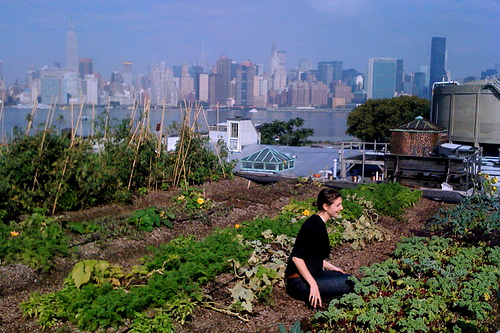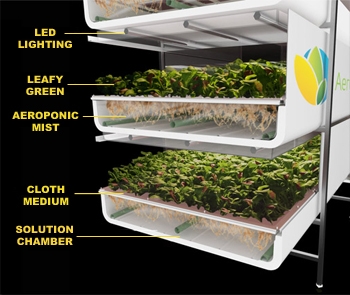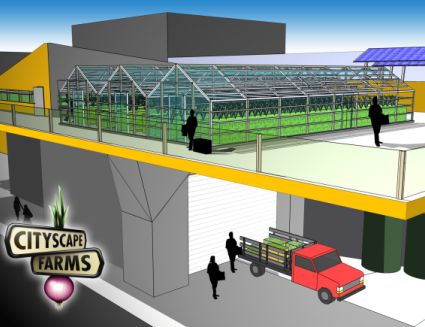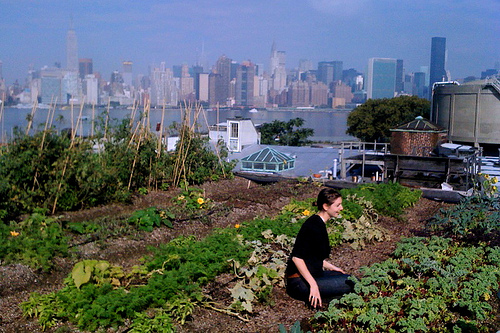 Photo via .hello foto of FlickrIn my last Green State column, I wrote about Agriculture 2.0. The conference, held in Silicon Valley recently, brought together venture capitalists and sustainable ag startups in an effort to jump start a market for the regional distribution of fresh food.
Photo via .hello foto of FlickrIn my last Green State column, I wrote about Agriculture 2.0. The conference, held in Silicon Valley recently, brought together venture capitalists and sustainable ag startups in an effort to jump start a market for the regional distribution of fresh food.
This week I take a closer look at some of the companies that tried to catch the ear and checkbooks of the high-profile investors who packed that confab at the Four Seasons in Palo Alto.
One of the more intriguing ideas came from startups thinking outside the agribusiness box by developing urban farms in a box. Literally.
Take AeroFarms. The New York company builds aeroponic farms that fit inside containers — soil and sun not required. The containers, which can be stacked on top of each other in warehouses and old buildings, have the potential to transform blocks of abandoned structures in places like Detroit or Newark into agri-lofts tended by urban farmers.
“This puts buildings back into play with a technology that would do something productive and employ people,” Ed Harwood, AeroFarms’ founder and chief executive, told prospective investors at the conference.
 Here’s how it works: Leafy greens — say, arugula or lettuce — are planted in a cloth bed and irrigated with a nutrient-infused mist that is applied directly to the plants. Light is provided by LED lamps, which are more energy efficient than conventional lighting and can be placed closer to the beds. The LED lamps also provide pest control, says Harwood, because they can be set to emit certain wavelengths that disrupt insects’ breeding.
Here’s how it works: Leafy greens — say, arugula or lettuce — are planted in a cloth bed and irrigated with a nutrient-infused mist that is applied directly to the plants. Light is provided by LED lamps, which are more energy efficient than conventional lighting and can be placed closer to the beds. The LED lamps also provide pest control, says Harwood, because they can be set to emit certain wavelengths that disrupt insects’ breeding.
(A video of AeroFarms vertical farming system can be found here.)
Harwood said AeroFarms is about to sign its first order — a deal worth between $1.5 million and $2 million. The startup has raised $500,000 from the investors 21 Ventures and the Quercus Trust.
Verdant Earth Technologies, meanwhile, wants to recycle all those shipping containers currently used by industrial agricultural to ship produce from continent to continent and turn them into seedbeds for a local food production system.
Racks of vegetables or herbs would be stacked inside the shipping containers. Josh Hottenstein, co-founder and chief executive of the Tucson, Ariz., startup, says one standard container can grow the equivalent of an acre’s worth of crops.
“We control the humidity ratio inside the container, the temperature, the air flow, the wavelength of the light, and alter how the plants grow,” he told investors at the conference. “We’re capable of increasing the uniformity of the crop when it comes out and the plants are ready for market.”
A centralized system can control multiple containers.
“The only labor involved is seed and harvest,” said Hottenstein, whose company, which was spun out of the University of Arizona, is looking to raise a relatively paltry $750,000 to get its product to market.
 San Francisco’s Cityscape Farms stressed its thrift as well, with chief executive Mike Yohay making a pitch for $200,000 to build Cityscape’s first two rooftop farms. (That’s on top of $300,000 that Yohay says the U.S. Department of Agriculture has already granted the company.)
San Francisco’s Cityscape Farms stressed its thrift as well, with chief executive Mike Yohay making a pitch for $200,000 to build Cityscape’s first two rooftop farms. (That’s on top of $300,000 that Yohay says the U.S. Department of Agriculture has already granted the company.)
“We see a lot of under-utilized space in the urban landscape, such as vacant lots and rooftops,” said Yohay. “Our vision is to transform cities into net food producers.”
To do that, Cityscape is developing an aquaponics system that combines aquaculture and hydroponics. Tilapia are raised in fish tanks and the filtered fish waste provides the fertilizer for growing organic crops in greenhouses. The water is then cleaned and recycled back into the fish tanks to complete the loop.
“Over the next two years the plan is to roll out two quarter-acre greenhouse farms to grow high-value crops — lettuces, herbs, tomatoes and tilapia, strawberries,” said Yohay. “Our target market includes 100 restaurants and 50 supermarkets committed to local sourcing.”
Cityscape’s business model is to earn revenues from the crops it grows in the Bay Area as well as from the fees it will charge to franchise rooftop systems and provide technical support.
Now’s the part of this column where we offer a reality check. These companies are, to varying degrees, in the early stages of development. Whether their technology will work as anticipated and whether a market will materialize remains to be seen (as well as whether food grown in boxes will actually taste good). And most importantly, only time will tell if these technologies can be scaled up to provide a credible challenge to industrial ag.
 Courtesy of Cityscape Farms
Courtesy of Cityscape Farms
There are plenty of hurdles to overcome. Cityscape, for instance, faces a potential bureaucratic nightmare in getting permission to build fish farms and greenhouses on urban rooftops. (“It keeps me up at night,” Yohay said. “The building codes have not kept up with urban agriculture.”)
And there’s no guarantee that food grown locally will be consumed locally. (Though that’s a good bet in places like the Bay Area, with its scores of farmers markets. I can’t imagine Cityscape would have trouble selling its produce in my home base of Berkeley, with its three organic farmers markets a week.)
That said, what’s striking is the conceptual breakthrough the startups represent. These entrepreneurs are not hippies, but they carry a subversive message when it comes to food production — one that, judging by the interest ofsome of Silicon Valley’s most prominent VC firms, is resonating with investors.
In closing his pitch, Yohay appealed to the sleek-suited crowd’s desire to do good by doing well.
“This is about a lot more than earning a return on your investment,” he said. “It’s about co-creating a model of food production that really reverses the historical damage agriculture has done to our planet. This is about feeding our increasing urban population nutritious, accessible food and connecting them to the source of that food like never before.”



